Olympic Site, Canning Town & Deptford
London. Tues 29 June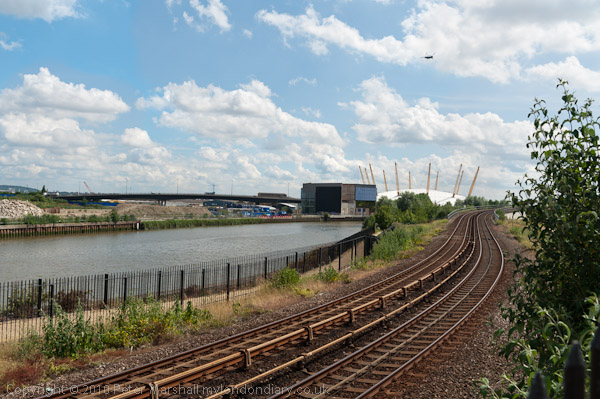
DLR, Bow Creek and former Pura Goods site at Canning
Town
more pictures
After taking some single images of the Olympic site and having a cup of tea
with the artist I had gone there to discuss a joint project with, I got on
my bike to ride to Deptford. On the way I made a few detours, though was unfortunately
unable to gain access to one area I'd hoped to photograph I did find quite
a few things to do, and the journey took me several times as long as I'd expected.
I rode from there back into central London, taking a leisurely route through
Rotherhithe and along the Thames Path until I realised I might be late for
the meeting I was going to. But it really is surprising how fast you can get
through the city in the rush hour on a bike and I made it in plenty of time.
If anything I went rather faster than usual, spurred on by the other speeding
cyclists making their way home through the snarled traffic.
more pictures
Olympic Pans
Bow &Stratford, London. Tues 29 June

The View Tube and Olympic Stadium
more pictures
Although I've aimed to visit the Olympic site to see the progress there roughly
on a monthly basis, its actually been rather longer since my last visit there.
Probably the biggest difference is in the crowds of people, perhaps because
it was a nice day, with half a dozen school groups, students and a coach-load
of pensioners.
Unfortunately the viewing platform is closed whenever - as today - the adjoining
classroom is in use, which seems to be an example of thoughtless design. Perhaps
they might add some external stairs or even a separate facility. The proliferation
of fences continues, mostly to control the flow of people rather than for
any reason of security, making it trick to take photographs. For once I came
equipped with a monopod which I could use to photograph over the temporary
fencing - though not of course over the 10 foot high electrified security
fence.
more pictures
Lea Navigation & Urban Gardening
Lea Navigation, Bromley by Bow, London. Tues 29 June
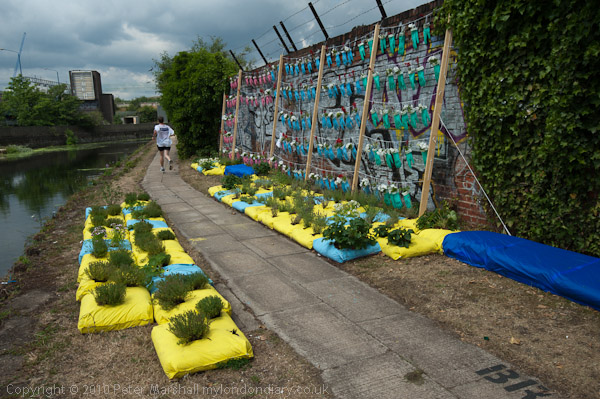
A jogger passes along the Lea Navigation tow path
more pictures
Had I been looking for this installation, part of the London Festival of
Architecture and produced by students from the University of Innsbruck I might
not have found it, as it was on the Lea Navigation itself, rather than the
Bow Back River. But I came across it and te other parts purely by accident,
taking a slightly roundabout cycle ride to the nearby Olympic site.
Of course it's an area already covered by art works of a sort, as you can
see from the wall behind the hanging gloves. After three days, some parts
of the 'gardens' had been a little altered, perhaps not exactly in the way
that the project intended with its aim "to activate local people
to participate in the urban farming," with a number
of the carefully placed watering cans now floating in the river.
One of the interventions was on the bridge where St Thomas's Creek (aka the
Bow Back River, though the name is used as a general term for the various
waterways on Stratford Marsh, most of which are currently inaccesible to the
public along most of their length due to Olympic security) leaves the navigation,
so in fairness I might have found it from the description of the location.
It was all a part of a much larger set of activities that took place, mainly
across the previous weekend along the main road leading through Bow to Stratford.
As well as the page of pictures on the Lea Navigation, there is a panorama
on the Olympic Pans page that also shows the junction
between the navigation and St Thomas's Creek.
more pictures
South Korea Exits World Cup
The Fountain, New Malden, London, Sat 26 June
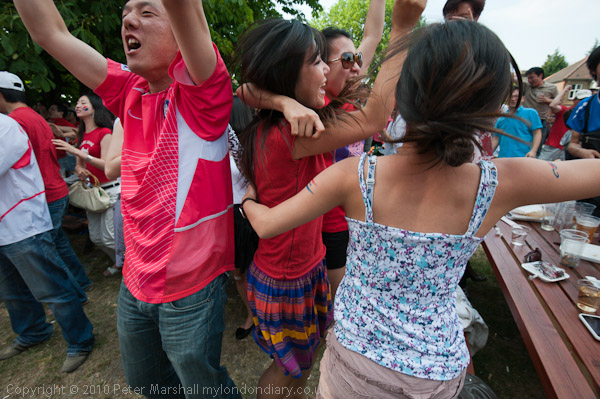
Celebration as South Korea equalise
more pictures
New Malden is the largest centre of the South Korean community in England, and
Koreans are a friendly and very sociable people who like to do things together,
including watching their football team. Along with many of London's South Korean
community I watched their country's defeat by Uruguay in the Fountain pub at
New Malden .
There were groups around each of the large screens in the bar of the pub,
a large local landmark next to a roundabout at the south end of New Malden
High St. Behind the pub a large garden with picnic tables and a grassed area
conviently slopes down from the roadside car park, giving the hundreds of
people seated and standing there a good view of the very large screens along
the lower edge.
Most of those watching were Korean, with a sprnkling of locals, there both
to watch the game and to enjoy the atmosphere as the crowd got caught up in
the events on screen. It really is a completely different experience from
watching at home, and in many ways better actually than being in the stadium.
Apart from being able to enjoy the beer and food, I only saw one vuvuzela
- and I didn't even hear it being blown.
An early goal by Luis Suarez had put Uruguay into the lead, but for much
of the match South Korea looked the better side and there were plenty of incidents
to raise the supporters' hopes. Uruguay too had a number of chances, including
one ball heading for goal that hit a Korean player's hand and was deflected.
There were several missed chances before South Korea finally equalised after
around 68 minutes and the crowd went mad, jumping up and hugging each other.
But there were now some more serious attacks by Uruguay and after a couple
of near misses Suarez again scored with just ten minutes of the game remaining
with one of the better goals of the tournament. South Korea continued to have
chances but Urugauy, perhaps rather luckily, remained ahead at the final whistle.
It was a match that could have gone either way and probably a tougher fight
than Uruguay will face in the next round.
more pictures
Admiral of the Port's Challenge
Westminster Bridge, London. Tue 22 June 2010
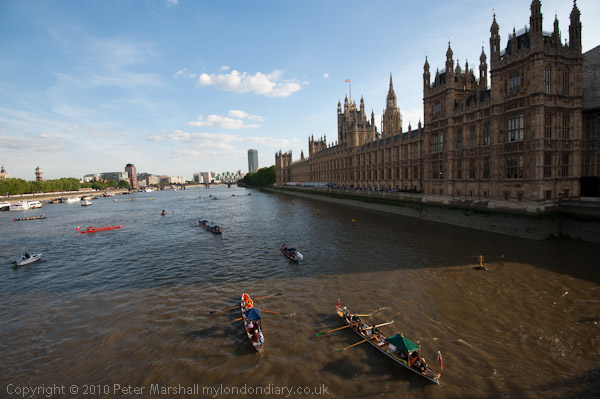 The race starts in several waves from outside the Houses of Parliament
The race starts in several waves from outside the Houses of Parliament
more pictures
Like me you've probably never heard of the Admiral of the Port's Challenge,
which I think is another of those rather recent traditions. Google doesn't
appear to find anything about it happening before 2008, so that may have been
the first, and thec class of boats that take part only dates back around 25
years. I only found out about it as I just happened to be walking back to
Waterloo over Westminster Bridge as it started on Tuesday evening.
The Lord Mayor of London is also Admiral of the Port of London, and this
is a race between "traditional" Thames Waterman's Cutters,
34 feet long and 4 feet 6 inches wide, with fixed seats for rowers and a canopy
for passengers, to the rear of which the cox sits. It's a design that resembles
the traditional craft used on the Thames, such as the shallop, based on those
in paintings from the 18th century, but adapted and built to be fast and stable
for modern use for the Thames 'Great
River Race' which started in the 1980s.
Cutters can be either rowed or sculled and unlike modern racing craft can
handle coastal waters - in 1999 a team from the Dittons Skiff & Punting
Club using a squad of 15 rowers taking turns in a six sculled cutter
rowed to Paris in just over 106 hours despite being held up for 12 hours at
Dover by a storm before they could row across the Channel and down to the
mouth of the Seine. Cutter racing is apparently a sport growing in popularity
with the less idle filthy rich, and a number of the 25 cutters now racing
on the Thames are owned by guilds and other organisations connected with the
river, such as Trinity House and the PLA.
For this race they are rowed by four people each with a single oar and must
carry two passengers under a ceremonial canopy as well as a cox. Although
the rules don't mention it, I suspect it's obligatory for the passengers to
sip champagne over the whole course, and it was a pleasant evening for it,
though the rowing looked too much like hard work. (Actually though I did see
a couple of glasses on one of the boats the rest weren't drinking, but I expect
there was plenty waiting at the finish.)
The race is over a 1.33 mile course (according to the PLA web site) and is
against the clock, although the boats start in 'waves' to give them something
to row against. I don't know what the winning time was, but the tide was with
them and it shouldn't have taken very long.
more pictures
Budget Day in Westminster
Parliament Square etc, London. Tue 22 June 2010
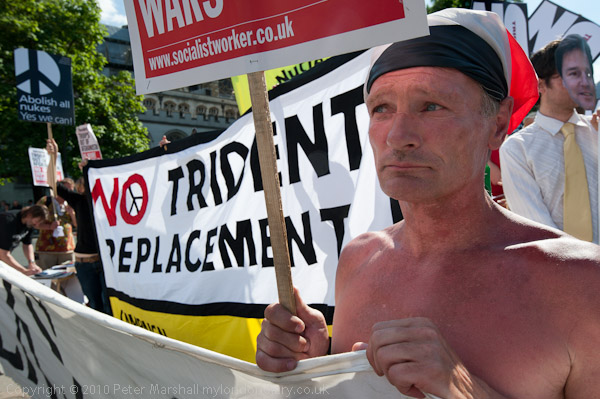
The last event of the day I photographed was the CND/Stop
the War demo
more pictures
Among the groups demonstrating around Parliament Square on budget day were
the PCS, 'Can't Pay Won't Pay', Stop the War and
CND, the Democracy Village and Brian Haw's continuing Parliament
Square Peace Campaign.
So many things were happening around Westminster that it wasn't possible
to photograph them all. I got to Downing St just as probably the biggest demonstration
of all was packing up, with trade unionists and climate campaigners demonstrating
against the coming cuts, having been held up taking pictures the Democracy
Campers calling for an end to the war in Afghanistan and the save return home
of the soldiers; after reading a list of the names of the 300 dead they made
a short-lived attempt to stop the traffic for a minute of silence, but were
quickly pushed back by police.
A little later I found a PCS demonstration outside the treasury and photographed
that, and then later went with the Democracy campers along with their banner
to the media village on College Green. Then along came the thirty or so 'Can't
Pay Won't Pay' campaigners, with a coffin and a little street theatre (it
even got them a short mention on the BBC) and I followed them back to Parliament
Square, missing a couple of attempts by the campers to make citizens arrests
of a Milliband and Ed Balls for their support of the illegal invasion and
occupation of Iraq.
By the time I did get back to College Green, that bit of action was just
coming to an end, but King David was there - I'd met him earlier when he had
been demonstrating with the PCS, and had just been the subject of a peculiarly
"potty plod" incident, the kind of thing that gives the police such
a bad image with the public.
King David's career as a boxer (unbeaten in his fights) came to an end in
1994 when he lost his left eye and received horrific facial injuries as a
result of a shotgun blast. One of the issues on which he has campaigned is
gun violence, with proposals for practical action to cut down gang gun violence,
which he accuses Mayor Boris Johnson of ignoring and treating him in a discriminatory
way.
As a part of his very individual campaigning approach, he uses a part of
a brass ornamental pistol, which you can see him holding in my picture. It's
really difficult to think why any police officer should consider this to be
a reason to search him under terrorist legislation, the reason given on the
stop and search form he showed me. Incidents like this give the Met a bad
name, and King David should at least receive an apology from the force, and
the officer concerned some kind of reprimand, but I suspect it's unlikely
to happen.
Of course there were politicians around, trying to look important, but mainly
seeming rather boring (with the exception of Caroline Lucas) men in grey suits.
Another set of men in gray suits came with placards and masks to protest about
the housing crisis, with the lack of affordable homes made much more serious
by the coalition's actions. And a man with a megaphone was lampooning the
whole thing and getting some attention from the police who tried to move him
away from the broadcasters while clearly trying to avoid arresting him.
Continuing at the centre of all this was the Parliament Square Peace Campaign
(PSPC), there since June 2, 2001. Brian Haw and Barbara Tucker have been dragged
into a court case brought on my the presence of the urging, and Brian was
in court until the afternoon. The court had earlier refused to allow Mrs Tucker
to give her evidence that the other protesters in the square had been used
as 'agents provocateurs', allowed to misbehave by the police in order to give
a pretext for the removal of the PSPC, which has previously been granted a
legal right to remain.
One of the more ludicrous claims of the GLC case is the huge amount they
say will be required to restore the square to its previous state after the
clearance of the camp. As a regular visitor to what has for many years been
one of the more neglected areas of London, I can attest that much of the grass
has already recovered from the various events not connected with the camp
that have taken place (as they do regularly) before the camp arrived, and
that given a few days work by a couple of gardeners to break up some of the
hardened earth path and perhaps a few handfuls of grass seeds the rest would
soon revert to its normal rather poorly grassed state. Perhaps they based
their claim on making available as an extra centre court for Wimbledon!
The last event before I left was a demonstration by Stop the War and CND,
pointing out that the war in Afghanistan had cost more than £20 billion,
and that a large saving could be made by deferring or cancelling the replacement
of our Trident nuclear deterrent, for which there is no longer any possible
military justification, presumably why it has been excluded from the military
spending review.
more pictures
UAF Arrive to Oppose EDL
Whitehall, Sun 20 June 2010
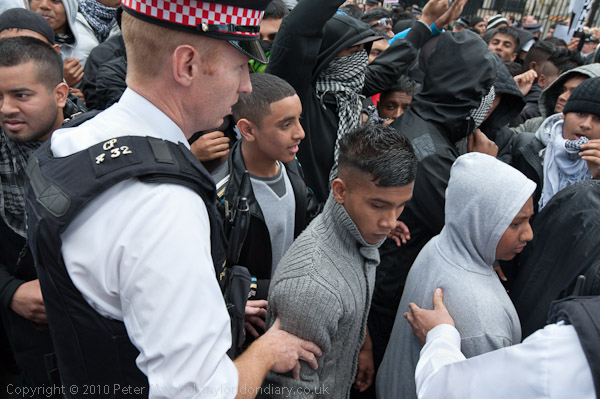
Police made sure the young Asians kept inside their
cordon
more pictures
See text below
EDL Oppose Muslims Against Crusades
Whitehall, Sun 20 June 2010
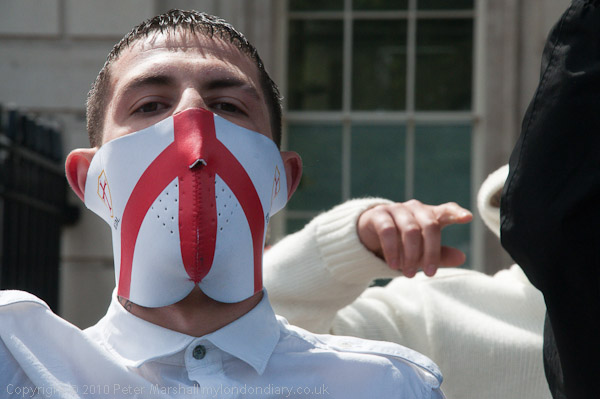
One of the protesters wore a St George's flag mask
more pictures
See text below
Muslim Crusaders For Sharia
Whitehall, Sun 20 June 2010
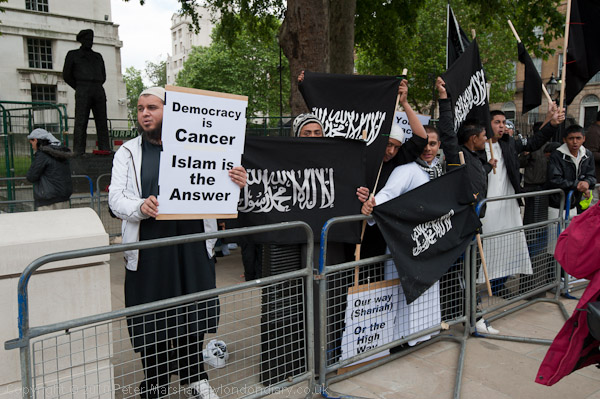
Another placard read 'Sharia over your noses whether
you like it or not'
more pictures
No Sharia - One Law For All
Whitehall, Sun 20 June 2010
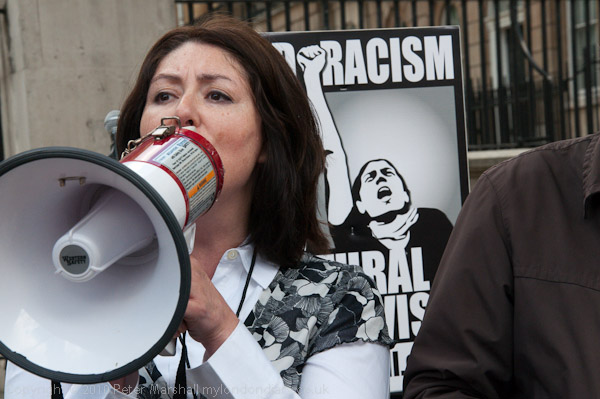
Maryam Namazie speaking opposite Downing St
more pictures
One Law for All held a rally at Downing
St calling for an end to Sharia and other religious laws. Radical Muslims
came to oppose them, the EDL to oppose the Muslims and Asian youths to oppose
the EDL.
The One Law for All rally was held on the anniversary of the the killing
of Neda Agha-Soltan in Iran, and after the rally the several hundred taking
part marched to the Iranian Embassy in Kensington.
When I arrived at the start of the protest there was already a very powerfully
amplified group of mainly young muslims in black in a pen a few yards down
the road from the One Law for All protest. When I asked who had organised
this protest I was told 'Muslims Against the Crusades' or 'Muslims
Against Crusaders', a group widely thought to be a reincarnation of the banned
'Islam4UK' (itself a relaunch of the banned Al-Muhajiroun.)
Their policy was perhaps summed up by one of the placards held up, 'Shariah
over your noses - whether you like it or not' and others such as 'Democracy
is Cancer - Islam is the Answer' and 'Sharia will dominate the World'
The One Law for all protest continued with speeches which condemned the attempts
to introduce Sharia Law in the UK and faith-based laws in general. They called
for equality under the law and an end to the kind of religious repression
that exists in Iran.
Maryam Namazie made it clear that One Law For All was not anti-Muslim. She
repeats on the Iran Solidarity blog what she said at the rally: "The
battle against Sharia law is a battle against Islamism not Muslims, immigrants
and people living under Sharia law here or elsewhere. So it is very apt for
the Islamists to hold a counter-demonstration against our rally. This is where
the real battleground lies. Anyone wanting to defend universal rights, secularism
and a life worthy of the 21st century must join us now in order to push back
the Islamists as well as fringe far Right groups like the English Defence
League and the British National Party that aims to scapegoat and blame many
of our citizens for Islamism."
Ex-boxer King David, one of London's more flamboyant characters who I've
not seen for a while put in an appearance, going up to the Islamist demonstrators
and telling them that they were not proper Muslims because of the way they
were behaving - some had shouted insults at him - and what they were calling
for. The young protesters he talked to were non-plussed by his comments, but
were soon helped by an older man in brown who appeared to be one of the leaders
of the event who told them to ignore him.
Shortly after, a group of around 20 English Defence League (EDL)
supporters arrived, and were surrounded by police on the opposite side of
the road, preventing them from approaching the Islamists. After a while police
led them across to a third pen on the other side of the One Law protest, and
I went back to listen to the speeches.
Then I saw the police leading most of the male EDL supporters further away
down the road, where they were lined up against a wall and searched. It appeared
to be a blatant misuse of police powers although it was not clear under which
law the searches took place, as after I had taken a few pictures police insisted
I move away from the area. Although I don't support the EDL, they remain entitled
to the protection of the law rather than victimisation, and police should
be upholding their right to peaceful demonstration within the law which they
appeared to be attempting to do on this occasion. A few women and a family
taking part in their protest were allowed to remain, but the others were escorted
away.
Around half an hour later, a futher group of protesters arrived, marching
up Whitehall surrounded by a cordon of police. They were several hundred young
British Asians, mainly from London's East End and some were carrying Unite
Against Fascism placards. Earlier in the day there had been a march from
Stepney Green to a rally at Whitechapel organised by the UAF and United East
End against the EDL and they had come here to find them - but were too late
to do so.
As they arrived, the One Law for All and Iran Solidarity protesters left
for the Iranian Embassy, and I had to run to catch up with them, photographing
them as they passed two major religious sites, Westminster Abbey and Westminster
Cathedral. Both reminded me of the fights much earlier in our history against
laws that were dominated by religion; although much of our legal system (and
arguable the whole concept of Human Rights) was based on former religious
laws and a few curious vestiges remain - as the occasional prosecution in
recent years has shown - we now have a system largely based on secularism
and universal rights, and it is perhaps time that many on the left in particular
took the need to defend it more seriously.
more pictures
Umbrella Parade for Refugees
Whitehall to Geraldine Mary Harmsworth Park. Sun 20 June 2010
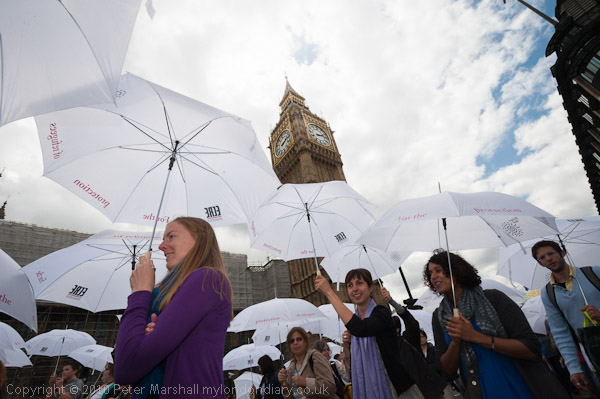
The parade passes Big Ben and the Houses of Parliament
more pictures
Several hundred marched through London in a World Refugee Day Umbrella Parade,
celebrating the protection of refugees and the great contribution they make
to our society.
The London parade, one of eight taking place in other European cities, came
at the end of Refugee Week and was organised by the Refugee Week partnership,
which includes Amnesty International, British Red Cross, Oxfam, Refugee Action
and Student Action for Refugees and works with ECRE, the European Council
on Refugees and Exiles, and the United Nations High Commissioner for Refugees.
The umbrella was chosen as "a symbol of care and shelter, representing
our proud tradition of offering safety to those in need of international protection,"
a tradition that is clearly under threat from the UK Borders Agency, with
forced deportation flights in which refugees are returned to an uncertain
future in Iraq, with beatings on the flight and on arrival.
We certainly have a proud tradition and a reputation that was well-deserved,
but competition between the political parties to be even tougher on immigration
and appease the right-wing press have serious eroded the chances of refugees
and asylum seekers receiving humane treatment and proper consideration in
the UK.
The march, which started outside the Defence Ministry in Horseguards Avenue,
made its way down Whitehall and past the Houses of Parliament and across Westminster
Bridge, on its way to a picnic in Geraldine Mary Harmsworth Park outside the
Imperial War Museum. Both start and finishing place were appropriate as most
refugees and asylum seekers are a result of war.
more pictures
Hare Krishna Chariot Festival
Hyde Park - Trafalgar Square, London. Sunday 20 June 2010
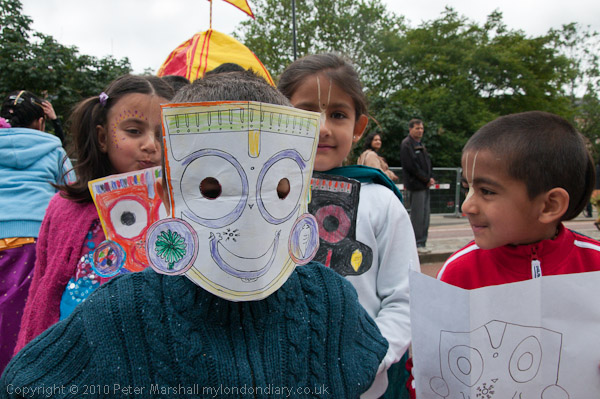
Kids with home-made masks wait for the procession
more pictures
The Rathayatra Chariots Festival took place on Sunday with several
thousand Hare Krishna devotees pulling three giant decorated chariots containing
Hindu Gods through the centre of London to a rally in Trafalgar Square.
The Rathayatra festival started at the Jagannatha temple in Puri, Orissa
on the east coast of India, which was built around a thousand years ago, but
the festival is thought by many to be much older, perhaps dating back as much
as 5000 years. It celebrates the time when Krishna grew up on earth and when
he became a great lord moved away from his childhood friends. These cowherds
visited him and tried to kidnap him and take him back to their village on
a cart.
Three Hindu deities are worshipped in the temple at Puri, and each is carried
on a separate chariot. They are Krishna in the form of Jagannatha,
his half-sister Subhadra, and Balarama her brother. Jagannath
means 'Master of the Universe' and his name and the chariots in the
festival gave the English language the word "juggernaut".
The chariot festival first came to the west to San Francisco in 1967, and
was brought to London by a small group of disciples from the International
Society for Krishna Consciousness (ISKCON, better known as the Hare
Krishna) two years later. Along with the three Gods, an effigy of the
founder of ISKCON, A.C. Bhaktivedanta Swami Prabhupada (1896-1977) is also
carried on one of the chariots in the festival.
The 30 ft high chariots were decorated in Hyde Park, and the deities arrived
by limousine and were lifted up onto them. People pull the chariots along
with large ropes attached to the front of the chariots and the road is swept
in front of them.
As well as the three large chariots there were several smaller ones in the
procession, along with musicians who were surrounded by groups of dancers,
at times jumping up into the air and waving their arms.
Trafalgar Square was decorated for the day and there were many tents with
information about Hare Krishna, as well as free vegetarian food, but I didn't
have time to stop.
more pictures
Peace Pagoda Celebrates 25 Years
Battersea Park, London. Saturday 19 June 2010
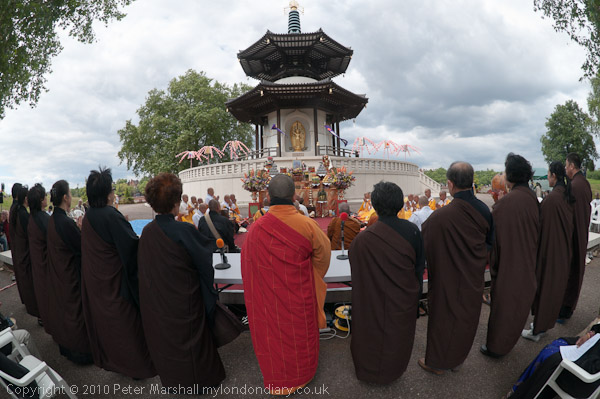
Monks in front of the Peace Pagoda
more pictures
The last legislative act of the
Greater London Council, as it was being
abolished for political reasons by Margaret Thatcher, was to approve the building
of a
Peace Pagoda in Battersea park by Japanese Buddhist nuns and monks
in 1985, 25 years ago.
The idea arose from a chance meeting in neighbouring beds in a maternity
ward between the wife of a man who had filmed the building of the Peace Pagoda
at Milton Keynes and a woman whose husband was on the committee responsible
for the GLC's Peace Year.
Milton Keynes became the site of the first Peace Pagoda in the western world
in 1980 after one of its planners had seen one in Sri Lanka, and the Nipponzan
Myohoji Order of Buddhist monks was invited to build one there. The order
still has its UK headquarters in Milton Keynes.
The Peace Pagoda movement was started by Japanese Buddhist monk, Nichidatsu
Fujii (1885-1985), founder of the Nipponzan Myohoji Order. He had worked
with Ghandi in India in the 1930s and in 1947 began to send out monks and
nuns across the world to build Peace Pagodas in a campaign against nuclear
weapons and for World peace and social and moral justice. The first two pagodas
were built in Hiroshima and Nagasaki, devastated by the atomic bombs dropped
by America the previous year. There are now around 80 of these shrines to
World peace around the world, mainly built by the Nipponzan Myohoji Order.
As Ken Livingstone said, the Peace Pagoda "demonstrates London's
commitment to supporting and celebrating peace around the world, and acknowledges
the important contribution of diverse cultures to London's vibrancy."
The ceremony began with a procession of monks and nuns from their temple
nearby in the park to the Peace Pagoda where they sat barefoot on the large
concrete plinth in front of an altar for the ceremony.
The anniversary service included some very musical chanting to the accompaniment
of bells and cymbals, and the burning of incense, though the smoke and scent
was rapidly carried away by a biting blustery wind. There were communal readings
from the Lotus Sutra, prayers and the ritual scattering of paper flower petals.
One of the more interesting parts of the proceedings was provided by several
groups of monks and nuns from other Buddhist traditions, each demonstrating
their different tradition of chanting.
This was followed by a procession by all those present led by the monks and
nuns up the steps of the Peace Pagoda and around it, pausing to pay respect
top each of the four large gilded representations of the Buddha.
The Anniversary ceremony concluded with an address by the Venerable Gyoten
Yoshida Shonin, Head Priest of Nipponzan Myohoji, delivered in Japanese, but
followed by an English translation read by the master of ceremonies.
The Peace Pagodas, as well as commemorating the victims of Hiroshima and
Nagasaki, are also intended as symbols of religious tolerance, and so it was
appropriate that this was then followed by interfaith prayers for World peace
from representatives from nine other religions - Baha'i, Brahma Kumari's,
Christian (Anglican, Catholic and Quakers) Hindu, Islam, Jain, Jewish, Sikh
and Zarthushti.
There followed a short welcome from the Mayor of Wandsworth, who hoped to
come back and see the Pagoda in another 25 years, and longer speeches from
representatives of various peace organisations, including CND, Trident Ploughshares
and Stop the War. Monks and nuns from the Battersea temple regularly take
place in peace demonstrations and events in London and elsewhere.
The event ended with tea and light refreshments being served while there
were some entrancing performances of devotional music and dance by the children
of the Thames Buddhist Vihara, a superb Kathak dance, and, as I was leaving
a set of songs by David Ferrard, accompanied by his guitar and Lucy Cowan
on violin. Despite the perishing cold wind coming along the river - strong
enough to blow the chairs over at times and often carrying some light rain
- I was glad I had taken part.
more pictures
Sikhs Never Forget 1984
Hyde Park to Trafalgar Square, London. Sunday 13 June 2010
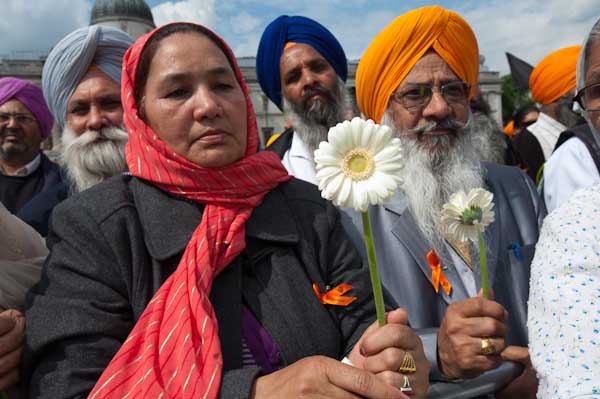
Flowers for a floral tribute to the 1984 massacre victims
more pictures
More than 5000 Sikhs marched from Hyde Park to a Trafalgar Square rally marking
26 years since the Indian Army attacked their most sacred shrine the Golden
Temple at Amritsar in June 1984, killing thousands. They called for an independent
Sikh state, Khalistan.
The march was an entirely peaceful event, and relatively few of those taking
part carried placards or wore t-shirts with political slogans, although there
were a few banners. At last year's events police had raised objections to
a number of placards and t-shirts with symbols of the proscribed organisation,
Babbar Khalsa International, militant Sikhs regarded by the UK government
as a terrorist group, as well as some with graphic images of massacre victims
and some naming prominent India politicians with a graphic image of an anonymous
head in a gun-sight. This year virtually nothing of this kind was visible,
with most taking part wearing normal Sikh dress. The main banner at the front
of the march simply called for 'Remembrance, Justice & Freedom.'
A few had flags with a Sikh emblem saying 'Khalistan Zindabad' -
Long Live Khalistan.
As usual the march was led by two men carrying Sikh standards, and behind
them the five baptised Sikhs (representing the Panj Pyare - the five Beloved
Ones) dressed in orange, with swords held up, walking barefoot, but other
than this there was less of theatre than on previous occasions, with only
a relatively small number of people scattered among the crowd carrying black
flags and a single black coffin being carried near the end of the march, rather
than a large group as before. Last year was of course the 25th anniversary
and so was something a a special event, which perhaps accounts for the lower
numbers this year. It was still a sizeable march, with around 40 coaches bringing
in Sikhs from around the country as well as those who had made their own way
there, and by the time the rally began in Trafalgar Square (there had been
a shorter rally at the start in Hyde Park) there were probably close to ten
thousand present.
To one side in front of the stage at Trafalgar Square there were a few black
coffins and some large slabs of flower arranging foam spelling out '1984'.
Several thousand flowers were distributed among the audience who then lined
up to plant these over around an hour while the speeches were continuing and
form a floral tribute to those who died in the massacres.
Around half of the speeches in Trafalgar Square while I was there were in
English, and a film shown on giant screens in two parts had English sub-titles.
From what I heard as I was taking pictures it seemed a clear and relatively
straightforward account of the events in India.
It's hard to avoid the conclusion that Britain made rather a mess of getting
out of the Indian sub-continent shortly after the end of the Second World
War. Partition itself was a particularly bloody process, and failed to take
into consideration the needs and aspirations of smaller and less vocal communities
such as the Sikhs. They had been loyal servants of the British Empire, many
losing their lives in two World Wars fighting for it, and the British government
felt they would continue as loyal servants of India.
The Indian Army launched Operation Blue Star in June 1984 against a group
of Sikhs who were agitating for an independent Sikh state of Khalistan and
were in the Golden Temple at Amritsar. The army attacked with tanks and heavy
artillery, destroying much of the temple and, according to independent accounts,
killing around 5000 Sikhs, many of them women and children (some Sikh sources
put the figure around twice as high.)
Sikhs blamed Indian Prime Minister Indira Ghandi for ordering the attack,
and in October 2004 she was assassinated by two Sikhs who were serving as
her bodyguards. Following this, there was widespread mob violence against
Sikhs, particularly around Delhi, incited by prominent members of the Congress
party, with police often giving their active support, and many thousands were
massacred across northern India.
Since 1984, both the fight for Khalistan and the persecution of Sikhs have
continued, although attracting little news coverage in the outside world.
Sikhs claim that over 250,000 Sikhs have been killed by in an orchestrated
genocide by the Indian government. So far as I could see there were no photographers
or reporters from the major news organisations at the start of the march in
Hyde Park, and few if any in Trafalgar Square.
more pictures
Gaza Flotilla Atrocity Protest
Whitehall - Israeli Embassy, London. Saturday 5 June 2010
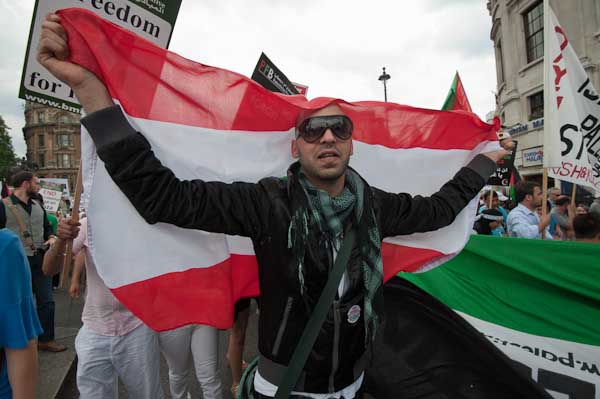
more pictures
20,000 marched from a rally at Downing St to another outside the Israeli
embassy to protest against the murder of peace protesters on the Gaza flotilla
by Israeli forces and to call for international action against Israel and
an end to the illegal Israeli blockade. Called by Stop the War Coalition,
Palestine Solidarity Campaign, British Muslim Initiative,
CND, Friends of Al-Aqsa, Viva Palestina and Palestinian
Forum of Britain, this was the first demonstration on Palestine to get
the whole-hearted offical support of the trade union movement.
The rally filled Whitehall and the crush around the platform was so intense
that I had to make my way out before the speakers had finished. Among the
speakers there were Caroline Lucas MP, Lindsey German, and
Tarik Ali and several flotilla survivors. Later at the Israeli embassy
there were more speakers including flotilla survivors Sarah Colborne,
Kevin Ovenden and Ismail Patel. Other speakers at the event
included Kate Hudson, Salma Yaqoob, Daud Abdullah,
Jeremy Corbyn MP, John Rose, Yvonne Ridley, Mohammed
Kosbar, Lauren Booth, Keith Sonnett and Sally Hunt.
Tony Benn spoke both before and after the march, as well as walking
the full distance. The final speaker was George Galloway, who received
an ecstatic reception, particularly from many of the Muslims in the crowd.
There was also an enormous repsonse to Lauren Booth, who complained of the
BBC coverage which had again and again broadcast the same lies from the same
Israeli apologist. As a story in the morning's Guardian by Robert Booth had
made clear the post-mortem findings are simply not consistent with the Israeli
account but the multiple shootings in the head at close range back up the
reports we heard from several of those who were there of more or less random
executions by some of the boarding troops.
I was not surprised but highly disappointed to hear on the news later in
the day the BBC report that 2,000 people took part in the event; my own estimate
was at least 10,000 and probably rather more. This is not an isolated error
- there is a consistent policy by the BBC to play down the scale of protest.
Occasionally they get caught out, as in the photographers demonstration in
Trafalgar Square where it was possible to actually count people in the photographs,
and the BBC figure was clearly shown to be less than a fifth of the actual
number present. But just why does the BBC continue to lie like this?
There were calls for international action against Israel over these and other
crimes against the Palestinian people, including the closing of the Israeli
embassy and the ending of their preferential trade agreement with the EU.
Several speakers compared the incident in international waters in which one
US citizen, Furkan Dogan, and nine Turkish citizens - Ibrahim Bilgen, Ali
HaydarBengi, Cevdet Kiliçlar, Çetin Topçuoglu, Necdet
Yildirim, Fahri Yaldiz, Cengiz Songür and Cengiz Akyüz - were murdered
with the massacre at Sharpeville which was a turning point in the SOuth African
freedom struggle. And many of them noted that although it was a great advance
that a UK prime minister was calling for the lifting of the blocade it was
only a first step.
George Galloway, speaking just before the rally due to a close with a period
of silence to honour the dead announced that there would be a concerted breach
of the blockade on a large scale after Ramadan ends in early September, with
both a land-based convoy and a further flotilla. After the killings on the
Mavi Marmara it seems to be a movement that is unstoppable.
more pictures
Release Carnival - End Child Detention
Torrington Square, London. Saturday 5 June 2010
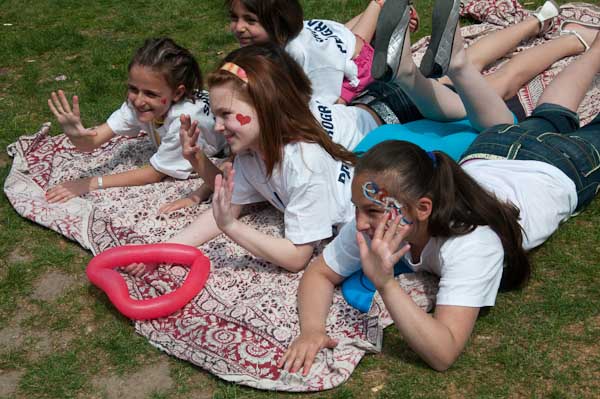
Albanian children wait their turn to perform
more pictures
The Release Carnival, organised by the SOAS Detainee Support Group called
for an end to the holding of children in immigration detention centres.
Although the UK Border's Agency states "treating children with care
and compassion is a priority for the UK Border Agency. Whenever we take decisions
involving children their welfare comes first" the reality is very
different. They are still simply being sent to detention centres where there
is little monitoring of how they are treated. These centres are run by private
contractors such as Serco and G4 whose main concern is profit. Official inspections
have made clear the real lack of proper care and maltreatment that occurs
in these institutions.
The experience for adults is tough, but for children it is entirely traumatic,
and is likely to lead to long-term negative consequences. They are taken,
often without notice and sometimes with inappropriate force, from communities
where they have set down roots, made friends and started schooling and locked
up in poorly equipped and extremely stressful surroundings. Some are kept
for considerable lengths of time - weeks or even more - with no idea what
is happening to them. For the roughtly one third of children detained who
are released and allowed to stay in the country it is seldom possible for
them to return to the housing and community where they were before detention;
those who are deported may face an even more doubtful future, with many deportees
being subject to harassment, imprisonment or worse on return to the country
from which they fled. Our treatment of adult detainees is a disgrace, and
extending similar treatment to children is shameful.
The Children's COmmisioner for England, Sir Al Aynsley-Green stated 'Detention
is harmful to children and therefore never likely to be in their best interests'
and he argued 'that detention of children for immigration control should
cease'. After I left the Release Carnival marched to Downing St where
they called for the immediate release of all families in detention.
more pictures
Ladies Day at Epsom
Epsom Racecourse, Epsom, Surrey. Friday 4 June 2010
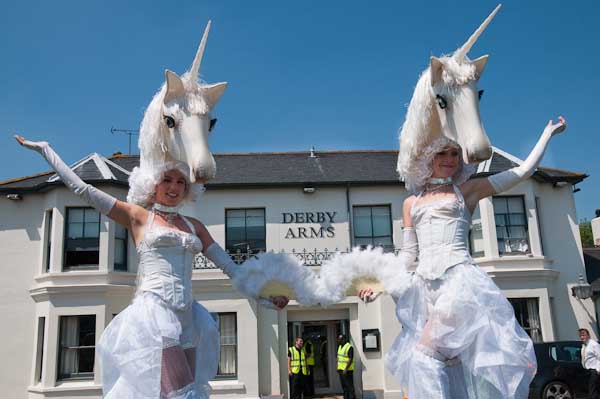
At least it provides an employment opportunity for unicorns.
more pictures
I've always refused to cover events which are a part of the social season
in London, such as Ascot and Henley (neither of which are actually in London
of course) partly because of my hatred of the class system but also because
I think its a greatly overworked vein so far as photography in the UK is concerned.
The Derby is a little different as it has traditionally been a great day out
for the working class of London, with entry to the Downs being free.
But several of my friends kept telling me I should go, so I applied for accreditation
on behalf of one of the libraries I work for, and my application was turned
down. But another photographer, Paul, who had covered the event in previous
years with accreditation but was also refused this year persuaded me to go
with him anyway, on Ladies Day, the day before the Derby itself.
It turned out to be a blisteringly hot day and we didn't stay long, but I
took a few pictures. Paul several times remarked on how the event had changed,
with far more areas now fenced off as paying enclosures and much more "corporate
hospitality", and where there used to be a large fair is now car parking.
The unicorns above are I think connected with some advertisement and there
was also a very tall lady in black with a large white poodle, but the Derby
Arms serves a decent pint at a reasonable price.
We walked through the tunnel under the course to the centre to watch the
first race and although there were quite a few people by the rails, it was
still pretty empty. It was also very hot, and after the race we decided it
wasn't worth staying and jumped on one of the buses going back to Epsom station.
I doubt if I'll bother to go again.
more pictures
Zionist Federation Support Israeli Atrocity
Israeli Embassy, Kensington, London. Wed 2 June 2010
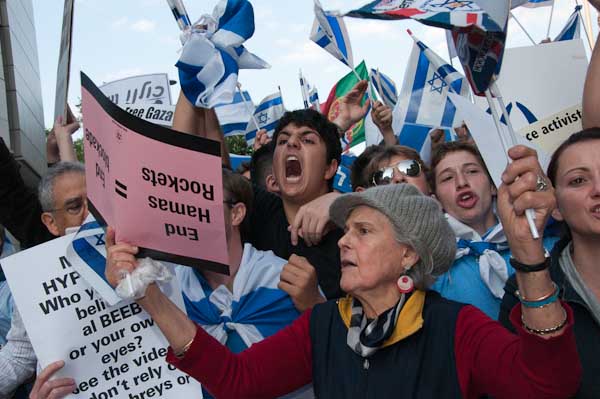
Protesters wave Israeli flags and scream insults at the pro-Palestinian counter-protest
more pictures
The Zionist Federation together with members of the English
Defence League demonstrated opposite the Israeli embassy in support of
the Israeli Defence Force killings in the attack on the Gaza aid flotilla.
When I left the demonstration shortly before it ended, there were perhaps
almost 500 people in a fairly densely packed pen on the road opposite the
Israeli embassy, many of them waving Israeli flags.
Fifty or so yards down the road was a second pen with only around a hundred
pro-Palestinian supporters - the Palestine Solidarity Campaign and the Stop
the War Coalition had decided not to support the counter-demonstration to
avoid conflict. Between the two groups were photographers and journalists
with a relatively small number of police. There were also quite a few police
vans parked in nearby streets, but fortunately there was relatively little
for them to do.
On the World Zionist Organisation web site, I read the statement
about the attack:
"The facts are yet to be collected and digested regarding exactly
what happened yesterday when the IDF intercepted the flotilla making its
way Gaza, but one thing is already clear: Our troops were surprised by the
response of those on board the ships, and the forces that were dispatched
were not sufficiently prepared for the scenario that developed, leading
to the regrettable number of casualties on both sides that from our point
of view were entirely unexpected."
In similar vein, the World Jewish Congress statement, although going
on to condemn both the peace activists and world media, starts by stating:
"The World Jewish Congress (WJC) expresses sincere regret at
the violence and loss of life during the attempt by Israeli forces on 31
May 2010 to take control of a ship that had broken Israel's legally sanctioned
naval blockade in international waters heading for Hamas-controlled Gaza
Strip." (The legality of the operation is a matter of dispute.)
So I was saddened by the overall mood of the pro-Israel demonstrators, which
appeared to be one of a gloating triumphalism that seemed entirely inappropriate
to the situation, and sickened when at one point a large group of the demonstrators
began chanting 'dead Palestinian scum'.
I had been appalled to find that this was to be a demonstration jointly with
the Zionist Federation and the English Defence League, some of whose members
many of us have seen and heard chanting racist slogans on our streets. It
seems unbelievable that a Jewish organisation should align itself - even if
unofficially - with people like this. In the event relatively few of the EDL
attended, but there was an added unease during the event with the presence
of sinister black-shirted security men (the Jewish 'Community Security
Trust') - the surely an entirely unfortunate choice of dress in a city
whose collective memory still remembers Mosley even if few are still around
who fought him on the streets.
Many of the demonstrators carried placards with the message 'Peace Activists
don't use weapons' but to expect even peace activists to welcome commandos
attempting to take over their vessel seems rather disingenuous. If the photographs
of these 'weapons' provided on the WJC website represent them accurately,
they are almost entirely exactly the kind of tools that would be expected
to be found on any ship in its galley and for general maintenance, as well
as items being taken for building work in Gaza. The possible exceptions are
a few canisters of pepper spray, some catapults and what looks like some kind
of ceremonial knife. Many will now have watched the videos of the event, including
one which appears to show the summary execution of one of the victims by shots
to the head at close range, an atrocity confirmed by the post-mortem reports
on him and others.
Other slogans included 'Israel wants peace not terror' and 'Free
Gaza from Hamas.' Although there are indeed many in Israel who want peace,
many around the world feel that the actions of the state of Israel in their
attacks on Gaza, their disruption of everyday life for the Palestinians and
the blockade is making the possibility of peace much more distant. I'm not
a supporter of Hamas, but Israel needs to ask why Hamas enjoys such support
in Gaza and to change its own policies which have led to this. Like other
conflicts, resolution depends on winning hearts and minds and this can't be
done with tanks and bulldozers.
Although I had no problems apart from a few odd gestures, some press photographers
were threatened while covering the event and four were surrounded and chased
by a an angry group of threatening Zionist demonstrators at the end of the
protest, before police eventually stepped in to protect them.
more pictures
Protest for Murad Akincilar
Turkish Embassy, Belgrave Square, London. Wed 2 June 2010

A small group of protesters in front of the Turkish Embassy
A demonstration outside the Turkish Embassy in London called for the release
of trade unionist Murad Akincilar, arrested on a spurious charge of belonging
to a terrorist organisation while on an extended holiday in Turkey last September.
The small demonstratation was organise by Figth Racism! Fight Imperialism!
and Gikder to support the campaign being organised by the Swiss trade union
Unia.
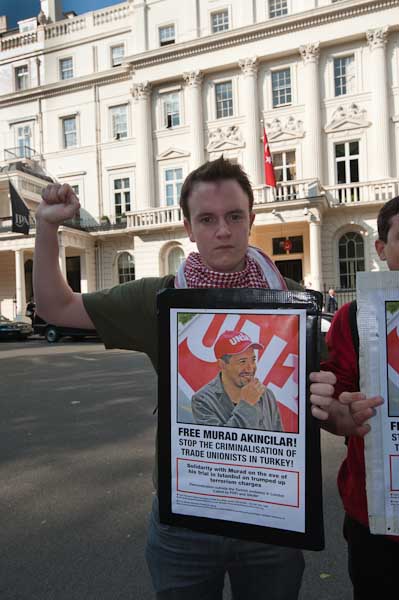
Murad Akincilar's is currently in prison in Istanbul. The alleged link between
him and the terrorist organisation was based on his writing an article for
a progressive organisation which is not banned, but which uses the same internet
provider as a banned organisation. There are strong hopes that he will be
released when his case comes to court today, June 3.
Arrested on 30 Sept 2009, Akincilar was first brought to court four days
later and remanded in custody. His treatment in prison has resulted in serious
eye damage and partial blindness.
Eighteen years ago Akincilar studied for a Masters degree at the LSE and
was known to some of those on the demonstration during his time here. Since
2001 he has lived in Switzerland where he has worked for the Unia, the largest
and fastest growing trade union in the country with strong membership in construction,
industrial and commercial sectors and has been active in campaigning for rights
for migrant workers, where Unia has acheived much in improving their status
and legal situation.
BP Picket for Colombian Oil Workers
St James's Square, London. Wednesday 2 June 2010
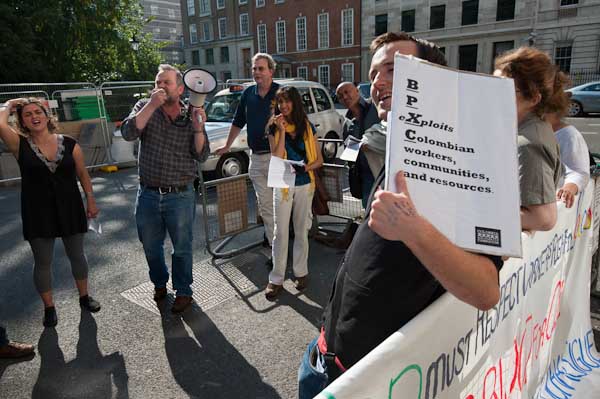
Protesters shout slogans against exploitation of Colombian workers outside
BP's offices
more pictures
The Colombia Solidarity Campaign organised a picket outside the BP HQ in
support of Colombian oil workers who have occupied a BP plant and are stopping
building works there.
BP's problems in the Americas are not limited to its leaking oil well in
the Gulf of Mexico. Further south in Colombia they have a long-running dispute
with the workers on the Cusiana oilfield in the Casanare department.
More or less as this picket was taking place, armed commandos from the Colombian
army leapt over a security grid at the plant and attacked the workers who
were carrying out a peaceful occupation of the Cusiana CPF (Central Processing
Facility) in Tauramena and controlled access to it together with BP's private
security personnel.
They had allowing production at the plant to go ahead normally but stopping
any building works on site, and had neither attempted to get the workers there
to join the stoppage or intimidate them. Contrary to management claims, they
did not stopped food and water being brought into the plant for those working.
The union members accuse BP of carrying out a campaign of misinformation
about what is happening in the plant, and in particular of falsely claiming
the support of government officials for their lies about the action.
A few years ago, BP came to an out of court settlement on a UK High Court
challenge over the pipeline from this oilfield to the coast, when farmers
alleged that BP benefited from the actions of Colombian paramilitary forces
who harassed and intimidated them in their protection of the pipeline. During
the preparation of the case, of the lawyers for the farmers discovered she
was on a death list and fled the country; she was granted political asylum
in the UK.
Since BP came to the area in the 1990s, the region has been under military
occupation, with executions being carried out by paramilitary groups creating
a climate of fear that has allowed BP to make its profits with little concern
for unions or human rights. BP largely disclaims any responsibility for the
problems as it works mainly through Ocensa, a company it set up and in which
it has a 25% shareholding, and the state oil company Ecopetrol which operates
for it. The USO wants BP to use its huge influence on Ocensa, and also for
it to recognise the union for its own employees in Colombia.
The negotiations between the oil workers and BP cover a wide range of issues
and the arguments for the people are put by the oil worker's union (USO) and
the Movement for the Dignity of Casanare. The breakdown in talks is in the
labour negotiating commission, but BP have used it as a pretext to threaten
the progress of the other commissions on environment, human rights, social
investment and the supply of goods and services.
The workers want their human rights and also the recognition of the USO,
the Workers United Union, which has been fighting for the dignity of workers
for 87 years. Among those speaking at the picket was Jim Catterson of the
ICEM, the International Federation of Chemical, Energy, Mine and General Worker's
Unions. Based in Switzerland, the ICEM represents more than 20 million workers
around the world, uniting trade unions in its sector around the world. He
issued a warning to BP that they need to take their obligations to the Colombian
workers much more seriously than they appear to at the moment. Other speakers
included Francisco Mora of the Colombian National Transport Workers Union
and Andy Higginbottom from the Colombia Solidarity Campaign.
BP were urged to conduct productive and peaceful negotiations with the USO
and other community representatives in Casanare. Their demands are just and
should be met and there must be no victimisation of union members.
The Colombia Solidarity Campaign intend to carry on their protests at BP
on a weekly basis with a picket each Thursday at BP as well as organising
other activities in a campaign for justice for the oil workers.
more pictures
Black Cabs Protest
Aldwych, London. Wednesday 2 June 2010
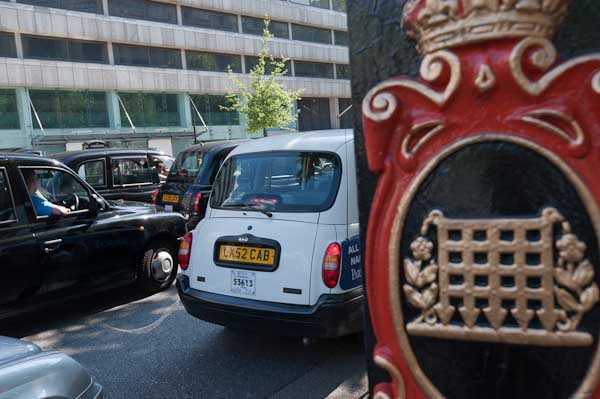
Cabs - one with numberplate ending 'CAB' and lamppost in Aldwych
more pictures
Several thousand of London's 'black' cabs came to Aldwych today to demonstrate
against the the unfair victimisation of London Taxi drivers by Transport for
London, the Public Carriage Office and Westminster city council.
This the second such demonstration by London black cab drivers and more actions
may well take place once the World Cup is over. An estimated 3,000 cabs came
to Aldwych, causing considerable disruption and delay to London traffic. As
well as current drivers, the action was also supported by a number of 'knowledge
boys and girls' currently training for the job, who brought their scooters
to the event.
The cabbies fear that Transport for London (TfL) and Westminster Council
are aiming to get rid of London's traditional cabs with their uniquely high
standards and replace them by a cheaper and less qualified 'one tier' service
based on current 'private hire' standards.
They think that both organisations are deliberately dragging their feet and
refusing to apply the law, allowing Licensed Private Hire touts to form informal
and illegal ranks outside every club, pub and bar in the West End. Certainly
these have proliferated to an extent that shows that the situation is out
of control, and neither body have taken effective action against these activites
that are illegal under the Private Hire regulations.
Cabs have a legal monopoly on plying for hire on London streets, and in return
have to meet very strict standards, in particular the training on the 'knowledge'
of routes and destinations in London that takes several years of concentrated
study.
Some people argue that the availability of satellite navigation systems makes
the 'knowledge' irrelevant, but cabbies argue that these systems are no substitute
for the in-depth personal knowledge gained by several years of study. They
also strongly feel that people at TfL and elsewhere have views that are based
on myths about cabs rather than the actual situation.
As an example they quote a recent statement by a London Councillor that there
is a need for greater services by private hire as there are only 400 black
cabs available in central London at night - while the true figure is around
8000. Other widely held myths that mini cabs are always cheaper or you can't
get a cab after midnight and you can't get a cab to go south of the Thames
are equally unfounded. Fares in minicabs can often be considerably higher
and many 'black cabs' are seen in the early hours around south London.
The cab drivers have some other grievances, too, paticularly over the use
of the M4 Bus lane by Private hire and other vehicles, the persecution of
cabs by local authorities including Westminster and Camden and the lack of
proper control over licensing of drivers in the surburban boroughs (the 'yellow
badge' sectors.)
Police were more prepared to deal with this week's action, and closed off
various routes to stop the cabs simply driving around Aldwych. At one point
many cabs were diverted across Waterloo Bridge and had to drive around the
Waterloo roundabout before returning. Unfortunately although their actions
led to slightly less disruption around Aldwych, the result was traffic chaos
over a wider area, especially after cabs were diverted up Kingsway to Holborn
and then went on to jam Holborn Circus for some time.
The high level of support for the previous demonstration has prodded TfL
into some action, with the publication of a notice by the Public Carriage
Office (PCO) generally supportive of the licensed cabs, and in particular
halting the processing of all applicatiothe consultation planned for in August.
The demonstration, organised by the London Taxi Drivers Forum (LTDF),
united cab drivers across various organisations and unions, and the LTDF has
now decided to become totally independent of any trade organisation or association.
Further demonstrations can be expected unless effective action is taken against
those breaking the law, although these are not expected to take place until
September.
I'm not a user of London cabs, relying on buses and tubes to get around when
I haven't got my bicycle with me. While standing at a bus stop a couple of
weeks ago I counted over 30 empty taxis going past before my bus arrived,
and I couldn't help but think we could have a better public transport system
without taxis. But while they are still with us the regulations concerning
private hire should be enforced with much greater effect.
Along with many other Londoners, I also feel that it's a great shame that
so many are no longer black, but any colour and often plastered with adverts.
It's a change which has doubtless created some income for the individual owner
drivers concerned but has has I think vitally wounded their essential 'brand'
identity.
more pictures
Brian Haw - Summons Marks 9 Years
Parliament Square, London. Wednesday 2 June 2010
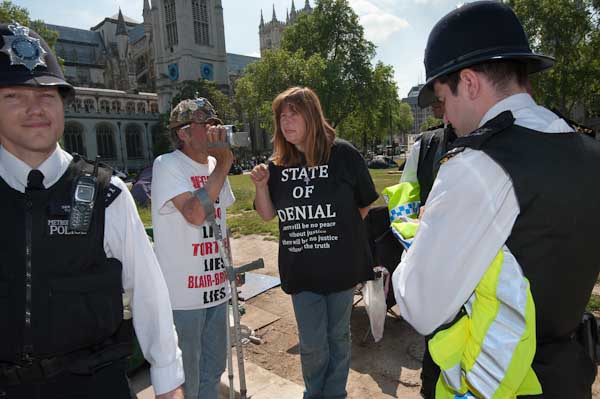
Police are filmed by Brian as they write a summons
for Barbara for using a megaphone in Parliament Square
more pictures
Brian Haw started his peace protest in Parliament Square
nine years ago, and today he was still there. Police marked the occasion by
serving a summons on his fellow protester Barbara Tucker for using
a megaphone.
I went to Parliament Square today to visit Brian Haw and Barbara Tucker on
the 9th anniversary of the start of Brian's protest vigil opposite the Houses
of Parliament in Parliament Square. Last week both Brian and Barbara were
arrested and held for 30 hours on the day of the state opening of Parliament
before the court released them on bail.
They were arrested as Brian objected to an early morning police search of
his tent, his home for the past nine years, without a warrant. The police
claimed to be acting under an act of parliament that allows them to enter
premises in the course of making an arrest, which was not the case.
Brian says that this was the thirteenth or fourteenth illegal search the
police have made of his property in his time in the square, all a part of
a continual campaign of harassment against him over the years.
As I arrived to talk with the two peace protesters, a group from the Democracy
Camp which has been in the square since May 1 this year were making a
protest across the road in on the pavement in front of the House of Commons.
They held up banners, including a large one saying 'We Respect The Soldiers
We Do Not Support The War' and another 'We Demand Peace In Afghanistan
and No More War' and several made speeches with a megaphone. Another
very artistically written notice on a large square of cloth on the pavement
read 'With Each Conscious Breath May You Know How Loved You Are in All
Ways. You Are Divine. Let Your Light Shine'.
Two young men who climbed up on the wall to hold a banner with five questions
for our government were soon told by a police officer to get down, and when
they didn't move fast enough he pulled the banner down; they came down and
held it standing on the pavement.
I walked back across the road to Barbara and Brian, pausing to photograph
the notice they have put up to make clear the distinction between what they
call the 'Police Camp' - since its activities seem tolerated by the
police - and their Peace Campaign which is subjected to considerable
police harassment.
I photographed Brian holding up a new t-shirt which reproduces the front
cover of The Independent, with a picture of the Queen at the state opening
reading the speech which stated 'Legislation will be brought forward to restore
freedoms and civil liberties', and below that one of police bending his arms
roughly behind his back during his arrest that same day.
The t-shirt Brian was wearing today was simpler and more direct: 'Afghan
Lies, Iraq Lies, Torture Lies, Blair-Brown Lies.' As I talked to them
we became aware of three police a few yards away standing and watching us.
They then came over and served Barbara Ticker with a summons for using a megaphone
in Parliament Square.
Brian and Barbara asked why she was being singled out for attention as there
were at that time others actually using a megaphone and she was not currently
doing so. The officers made no attempt to answer this question, though they
did look at the Democracy Village protest still taking place.
more pictures
Democracy Village Protest
Parliament Square, London. Wednesday 2 June 2010

Another small demonstration outside Parliament - see above
more pictures
Against The Deportation Machine 2
Beckett House, St Thomas St, London. Tuesday 1 June 2010
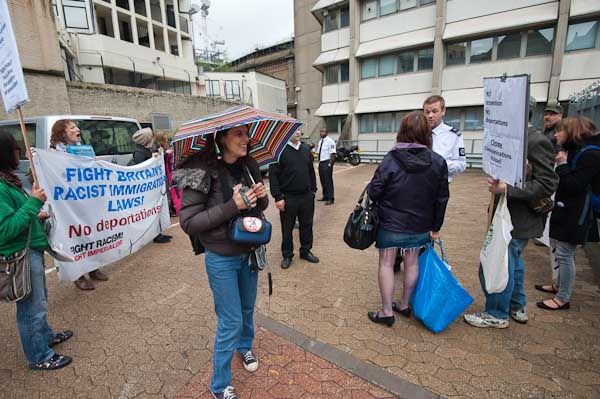
Security guards tell the demonstrators they can't stay in the car park of
Beckett House
more pictures
Against The Deportation Machine 1
Communication House, Old St, London. Tuesday 1 June 2010
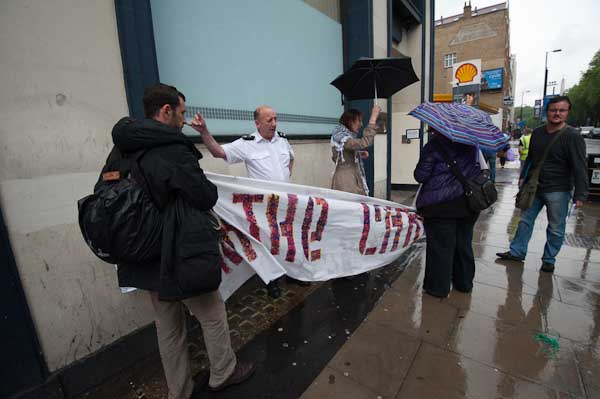
A security guard objects to the banner being taped to the wall
more pictures
As a part of the European Week of Action to Stop the Deportation Machine
there were pickets at the two immigration reporting centres in central London,
from which asylum seekers are sometimes detained and deported without notice.
Despite sometimes heavy rain, activists continued their lunchtime picket
of Communications House on Old St, a rather drab and run-down building
that requires a very close inspection to find it is an immigration office.
It is one of the reporting centres where refugees and asylum seekers have
to report in regularly, never knowing if they will be able to leave freely.
At one point security staff came out and insisted that the protesters remove
the banners that had been taped onto the wall of the building, and one of
them tried unsuccessfully to stop people taking photographs of him.
A second picket, with around thirty people present, was held later in the
afternoon at Beckett House near London Bridge station. After standing
outside for some time with placards and banners, the protesters made their
way to the car park at the back so that staff working on that side of the
building could see their protest. A group of security men came out and told
them they were on private property and would have to leave, which after some
argument they did, continuing the protest on the main road at the front of
the building.
A visit to any of the reporting centres may end with an asylum seeker being
escorted by security staff to an airport and put onto a flight back to their
'home country' where they may be wanted for political offences or have a realistic
fear of torture, violence or death - the reason wny many fled to seek asylum.
Often people are deported without being able to make contact with lawyers
- it is a system that lacks both compassion and justice, and sometimes appears
to be clearly motivated by racism.
Asylum seekers are required to sign on monthly, weekly or even daily, and
often have to make lenngthy journeys to do so, spending much of the small
amount of money they are given on fares. They are finger-printed and their
biometric ID cards are reactivated in a process which seems largely designed
to cause them hardship and humiliation.
They may be detained at any of these interviews without the need for any
warrant, kept in the secure cells there (short-term holding facilities) and
then transferred either to immigration detention centres or direct to flights
out of the country. People detained by snatch squads in dawn raids on homes
and workplaces are also often brought to these short-term holding facilities.
Since 2004, these facilities have been subject to inspection by the Prisons
inspectorate, and reports have identified their misuse for extended detention,
use of force, lack of information for those detained, inadequate facilities,
untrained staff, the keeping of women and children in the same room as single
men and many more "systemic deficiencies."
The centres are not run by the Borders Agency, but as a cost-cutting measure
are run for them by a private security firm, G4S, who are also the main providers
of 'escort services' for detainees and run a number of the detention centres,
which have been repeatedly criticised by the Chief Inspector of Prisons.
The organisers of the European Week of Action Against the Deportation Machine
are concerned at the increase in forcible deportations from European countries,
"increasingly carried out through joint coordinated 'operations'
involving private contractors and shadowy agencies like Frontex and the IOM."
They see freedom of movement from country to country as a basic right for
all people, who "choose or are forced to migrate for a variety or
reasons, from wars and armed conflicts fuelled by the arms trade and western
interests, through poverty, exploitation, discrimination, gender oppression,
domestic and state violence, to climate change."
Many of those who come to this country as refugees or as migrants possess
skills that are in scarce supply here - but asylum seekers are not allowed
to work, and migrants without permission to stay can only find low paid casual
work on the fringes of the economy with employers who exploit their precarious
position. Often they end up working for less than the minimum wage and in
unsafe or unhealthy conditions that would not be tolerated in normal employment
- sometimes with tragic results.
Asylum seekers and migrants - whatever their official status - are people
and our immigration services should treat them with respect for their human
rights and dignity. We need fair laws rather than the current essentially
racist polices established by governments keen to convince a right-wing press
that they are tough on immigrants, and to ensure that they are applied both
fairly and humanely. Immigration law should be about protecting rights and
not denying them.
more pictures
top of page
All pictures on this section of the site are Copyright ©
Peter Marshall 2010; to buy prints or for permission to reproduce pictures
or to comment on this site, or for any other questions, contact
me.






 The race starts in several waves from outside the Houses of Parliament
The race starts in several waves from outside the Houses of Parliament



















